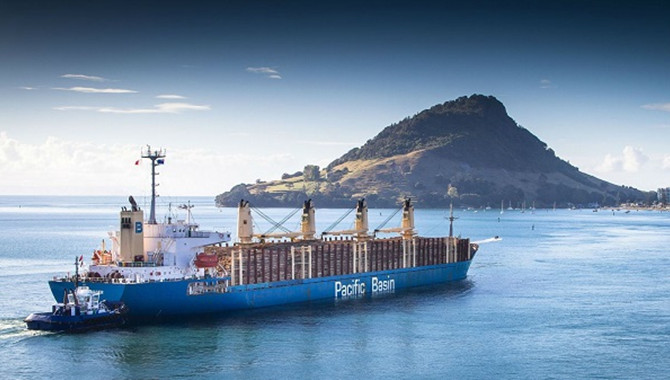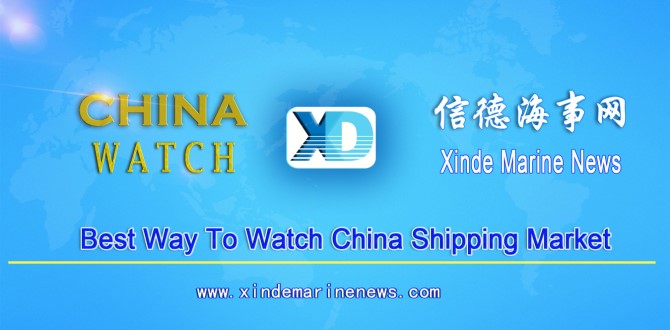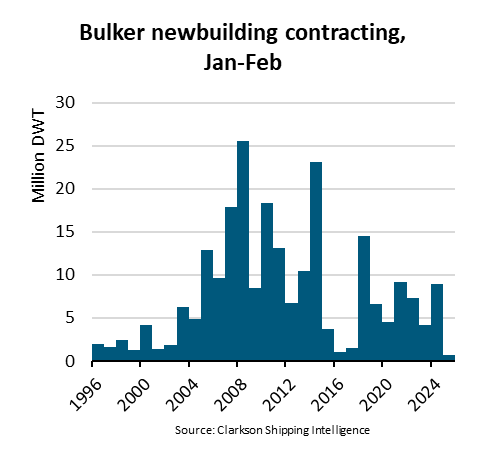
Pacific Basin Shipping Limited, one of the world’s leading dry bulk shipping companies, yesterday announced the results of the Company and its subsidiaries (collectively the “Group”) for the year ended 31 December 2019.
Mr. Mats Berglund, CEO of Pacific Basin, said:
“We made a net profit of US$25.1 million in 2019, an underlying profit of US$20.5 million and EBITDA of US$230.7 million. Our results benefited from our TCE earnings outperformance, enlarged owned fleet and competitive cost structure, but were adversely affected by weaker dry bulk market conditions and more off-hire than normal, especially in the second half of the year, due to scrubber installations and a record number of dry-dockings. In line with our dividend policy, the Board is recommending a dividend per share of HK2.1 cents.
Consistent with our fleet growth and renewal strategy, we took delivery in 2019 of eight modern secondhand vessels – six Supramax and two Handysize – and sold two older smaller Handysize vessels. By the end of April 2020, two further Supramaxes and one Handysize are scheduled to join and a further sold Handysize will exit our fleet, increasing our owned fleet to 117 ships.
We secured two revolving credit facilities, repaid and issued new convertible bonds achieving a lower coupon, and issued new shares as part payment for four ships. These funding initiatives enhanced further our balance sheet and liquidity position which at year-end amounted to US$383 million.
Looking to 2020, the seasonal Chinese New Year dip was compounded and prolonged by reduced demand and disrupted logistics caused by actions to contain the Coronavirus. Catch-up demand and stimulus should trigger a rebound once the virus is under control and Chinese activity returns. Hence, this year will likely be characterised by initial challenges and continued volatility. As we have shown before, Pacific Basin has what it takes to navigate such turbulence adeptly.”
BUSINESS COMMENTARY
Competitive at Every Level
While our average Handysize and Supramax daily TCE earnings of US$9,630 and US$11,720 per day net were down 4% year on year, our outperformance over the BHSI and BSI indices increased to 41% and 24% respectively.
Our ship operating expenses (“Opex”) of US$4,080 per day, general and administrative (“G&A”) overheads of US$730 per day and favourable financing costs of US$770 per day remain well controlled and are also very competitive compared to most of our peers, contributing to a competitive overall cost structure and vessel breakeven level on our owned fleet.
We have covered 42% and 60% of our Handysize and Supramax vessel days for 2020 at US$8,910 and US$11,390 per day net respectively.
Executing our Fleet Growth Strategy
We continue to grow our owned fleet with larger, high-quality secondhand acquisitions, focusing especially on Supramax ships of over 57,000 dwt. This is because the proportion of owned ships in our Supramax fleet is still small, larger ships enjoy greater upside in stronger markets, and since we believe that size creep and pressure to lower transportation costs and emissions per tonne-mile will continue to drive this segment.
In Handysize, we already have a favourable mix of owned versus chartered ships, but we are growing our carrying capacity by opportunistically trading up our smaller, older Handysize ships to younger and larger units of over 36,000 dwt resulting in an even more efficient fleet with greater longevity.
In early 2020, our owned fleet will grow to 117 ships. Including chartered ships, we operated an average of 229 Handysize and Supramax ships overall in 2019.
The number of ships we have on long-term charter continues to reduce – from 61 at the end of 2012 to around 18 on average for 2020 – as we replace them with owned ships and short-term chartered ships typically on one-year charters or less.
Strong Balance Sheet with Diverse Funding Sources
Our access to capital and cost of capital represent a significant advantage, as our fleet is financed through long-term facilities at the most competitive cost in our industry.
In May we closed a US$115 million syndicated 7-year reducing revolving credit facility secured against 10 of our previously unmortgaged ships, raising fresh capital at a competitive interest cost of LIBOR plus 1.35%. In November we closed a new unsecured US$50 million short-term revolving credit facility at an interest cost of LIBOR plus 0.75%.
Four of the vessels we committed to purchase in 2019 have been 33% funded by the issuance of new shares to the ship sellers. These ships-for-shares deals are accretive to our earnings per share.
In the third quarter, after most bond holders exercised their redemption rights, we repaid in full and cancelled all US$125 million of our convertible bonds due in 2021. We subsequently issued new convertible bonds, due in 2025 and with a lower coupon, to raise approximately US$175 million.
These initiatives reinforce our already competitive vessel break-even levels, enhance our operating cash flow, EBITDA and competitive strength, and further enhance our balance sheet and liquidity position so as to support the strategic expansion and renewal of our Supramax and Handysize fleet.
As at 31 December 2019, we had cash, deposits and undrawn facilities of US$383 million and net borrowings of US$663 million, which is 35% of the net book value of our owned vessels at the year end.
2020 Global Sulphur Limit
The IMO 2020 global 0.5% sulphur limit took effect on 1 January 2020. Like the majority of the global dry bulk fleet, about 85% of our overall fleet (including chartered ships) complies by using low-sulphur fuel. Our ships have made the switch without any major unplanned operational disruption, as we prepared thoroughly.
As Supramax vessels consume more bunkers than Handysize vessels, we chose a balanced approach to how we comply, took early actions to prepare for the expected volatility in fuel prices in early 2020 and installed exhaust gas scrubbers on a majority of our owned Supramax vessels allowing these ships to burn cheaper heavy fuel oil. In early February, we completed our scrubber retrofit programme with scrubbers successfully fitted and operational on 28 of our 35 owned Supramaxes. Having scrubbers on about 15% of our approximately 200 operated ships provides us some optionality in how we manage our fuel needs to comply with the new rules. Based on the fuel price spreads seen early 2020, our scrubber-fitted ships are making a significant contribution to our earnings.
Outlook & Position
In January, the IMF projected global growth to increase from 2.9% in 2019 to 3.3% in 2020 and 3.4% in 2021, citing a boost in market sentiment by tentative signs that manufacturing activity and global trade are bottoming out, a broad- based shift toward accommodative monetary policy, intermittent favourable news on US-China trade negotiations, and diminished fears of a no-deal Brexit.
Trade tensions between the US and China have subsided since the recent Phase One trade agreement which should support improved agricultural product exports and could be a catalyst for stronger dry bulk demand.
Further normalisation of ore exports from Brazil and Australia following last year’s infrastructure and weather disruptions is expected to support stronger dry bulk demand as the year progresses, coinciding with agricultural export seasons and resilient minor bulk demand.
However, these factors are currently overshadowed by the negative effects on China and the world economy of efforts to contain the coronavirus. While we do not know how long the outbreak will last, we do expect to see a rebound and stronger rates driven by catch-up demand and stimulus activity once the outbreak is contained.
Notwithstanding increased newbuilding deliveries, especially early in the year, the market should benefit from further fleet inefficiencies. Many larger ships will continue to be taken out of service for scrubber retrofits, and the majority of the world’s dry bulk vessels (especially in our segments) will increasingly sail at reduced optimal operating speeds – as has already been evident early in the year – due to the higher price of low sulphur fuel. This will mitigate effective supply growth in 2020 and beyond, and uncertainty over new environmental regulations and the gap between newbuilding and secondhand prices should discourage new ship ordering.
For Pacific Basin, 2019 was a year heavily influenced by investments and preparations for new environmental regulations, including scrubber installations, optimisation programmes, a record number of dry-dockings and continued acquisitions of quality secondhand ships – all serving to set us up for what we believe will be stronger markets in the longer term.
We will continue to pursue our fleet growth and renewal strategy. Over the long term, we see upside in secondhand values and our buying focus remains on secondhand Japanese-built ships for their good quality and value. We are still avoiding contracting newbuildings due to their high price, low return, and because of the uncertainty over new environmental regulations and their impact on future vessel designs and technology.
We support IMO’s ambitious greenhouse gas reduction goals. The new technologies required to meet these long-term goals will take time to develop, and we have joined the “Getting to Zero Coalition” to support this effort.
In the short term, what the industry can and should do to improve profitability and reduce emissions is to slow down existing ships and refrain from ordering new ships with old technology.
Having strengthened our balance sheet, our healthy cash and net gearing enhance our ability to ride out any challenging periods ahead and take advantage of opportunities to grow our business and attract cargo as a strong partner. Our robust customer-focused business model, high laden utilisation, global office network, experienced people, strong in-house technical capability, larger owned fleet and competitive cost structure position us well for the future.
Source: Pacific Basin
The opinions expressed herein are the author's and not necessarily those of The Xinde Marine News.
Please Contact Us at:
admin@xindemarine.com


 Ningbo Containerized Freight Index Weekly Commentar
Ningbo Containerized Freight Index Weekly Commentar  Ningbo Containerized Freight Index Weekly Commentar
Ningbo Containerized Freight Index Weekly Commentar  Ningbo Containerized Freight Index Weekly Commentar
Ningbo Containerized Freight Index Weekly Commentar  BIMCO Shipping Number of the Week: Bulker newbuildi
BIMCO Shipping Number of the Week: Bulker newbuildi  Ningbo Containerized Freight Index Weekly Commentar
Ningbo Containerized Freight Index Weekly Commentar  Ningbo Containerized Freight Index Weekly Commentar
Ningbo Containerized Freight Index Weekly Commentar